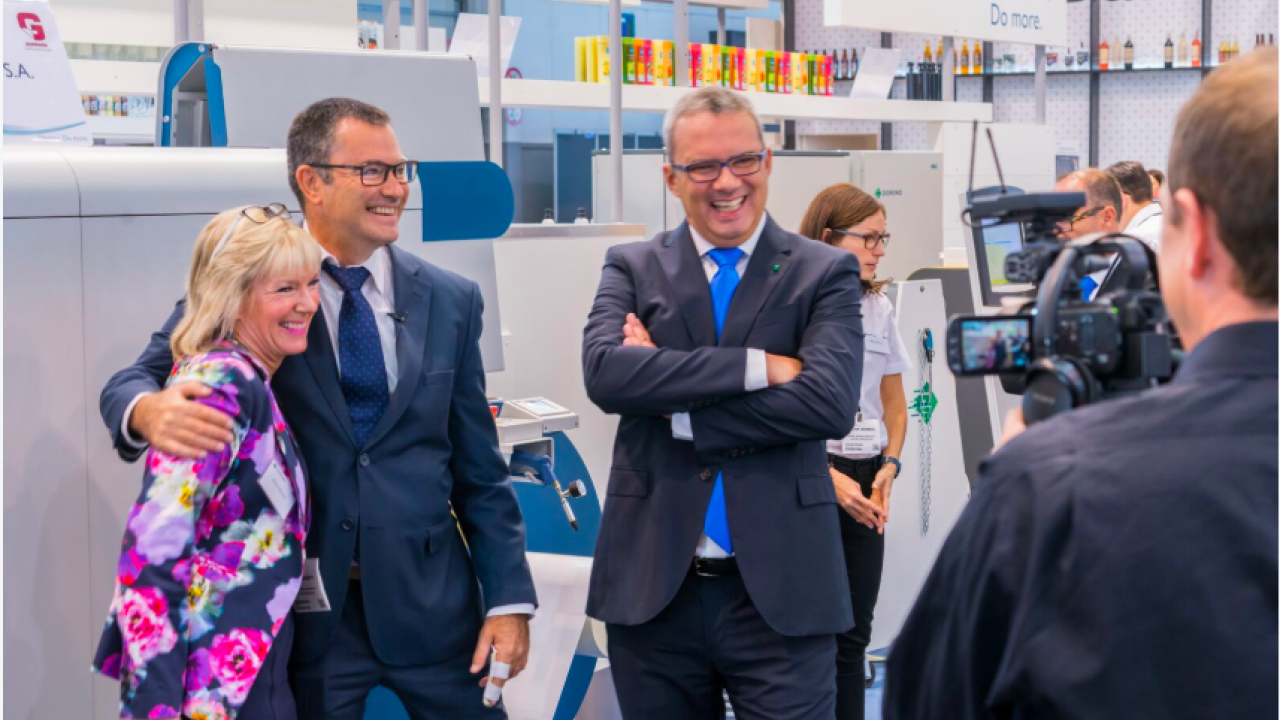Q&A: Iban Cid, Germark

Labels & Labeling: What has been the evolution of Germark’s business since its foundation?
Iban Cid: Germark was founded in Barcelona in 1958 by German Cid, my father. Initially the company was the Spanish agent for Guhl & Sheibler, a label systems manufacturer from Switzerland, selling mechanical printers for pricing labels to the retail market. That’s the origin of the company’s name: GER for German, my father’s name; MARK for price marking devices and the consumables, the labels. In 1960 we invested in our first Gallus press, which printed just one label shape in one color, for customers’ logos. In 1970 we began to develop our own line of label applicators and created the company’s Systems Division. We installed our first 5-color rotary press in 1976, and this was followed by several letterpress and MPS flexo/rotary silkscreen presses, a Xeikon digital press in 2000, an HP Indigo digital label press in 2006, a Cohesio from ETI Converting for adhesive and silicone coating in 2009, and an HP Indigo WS6800 in 2014, the first installation of the press worldwide.
L&L: Germark is well-known for its promotional labeling expertise. What are the specific challenges related to this segment?
IC: Promotional labels is a challenging market. We have to invest a lot in R&D costs and the sector demands high levels of service. But on the other hand we have less competition offering this type of label, and it makes us stronger in terms of innovation and production capabilities for specialty label applications. The first step is to understand the customer’s needs and then to propose a better solution, always keeping in mind that our final goal is to help them increase sales. What I can say is that in all the promotional campaigns where our work was present, we have achieved that goal.
L&L: What was the most important lesson your father taught you before you took over the family business?
IC: Not only for the business but for life in general: to be honest. In a business context, it means being honest with all the people who you are involved with: workers, suppliers, customers. In life, you reap what you sow.
L&L: Do you think a third generation of your family will join the business in the future?
IC: I’m not educating my three sons with that goal in mind. They will be whatever they want to be. If they are interested in the business, I’ll be happy. They would have to be well-prepared for the position for which they wanted to apply – just like in the real job market. Just because it is a family company does not mean family members can automatically have a job. Moreover, in the medium to long term, I see Germark being integrated into a large label converting group. Nowadays, in this global world, we are too big for small customers and too small for the big ones.
L&L: You have been president of both Finat and Anfec, and are currently president of the Catalan Guild of Graphic Arts. How important is the work that industry associations do, and what benefits has Germark gained from these memberships?
IC: The work done by the different associations is key and absolutely necessary for the industry. Someone has to do that work to the benefit of the whole sector. As an example, the Finat test methods are beneficial not only for the label printers but also for the labelstock manufacturers and the end users as well. But being president of an association is like being president of your building: all the neighbors approach to you with complaints, but none to say thanks. In the end, the main benefit that Germark or any member company can gain by joining an association is networking with industry peers. This has no price.
L&L: What are your proudest achievements during your tenures as president of these associations?
IC: I’m very proud of the foundation of Anfec in 1999. Now it is an established industry association, nearly 20 years old, with some 250 members. More recently, the challenge of maintaining the Antoni Algueró graphic arts school that belongs to the Catalan Guild of Graphic Arts. Despite the Spanish government’s policy of decreasing funding for this kind of school, we have the best graphic arts school by far in Spain, with all kinds of technology available to students, including two HP Indigo digital presses – a 5000 for sheet-fed and a WS4500 – with an AB Graphic line for label converting.
L&L: At Labelexpo Europe 2017, you invested in a Domino N610i inkjet press. Germark was an early adopter of digital technology from HP Indigo. What prompted the move into inkjet technology, and what benefits do you anticipate the system will bring the company?
IC: We were the first Spanish label printer to invest in a digital label press with the Xeikon machine in 2000. Then in 2006 we switched to our first HP Indigo. Now we have increased our digital capacity with the Domino UV inkjet press. Domino’s N610i digital inkjet press is a good complement to our existing print technologies. We conducted extensive research and visited two of Domino’s existing N610i customers in the UK and France before deciding to invest. We were particularly impressed by the high print quality, the cost-effective production costs, and with the added value capability to print digitally textured labels.
Besides the benefit of high print speed at full color, for us the greatest advantage of inkjet is the capability to imitate analogue silkscreen for short runs. We are very active in the health and beauty sector, where silkscreen is a must. But, similarly to other sectors, the trend is towards ever shorter runs.
L&L: What other equipment did you invest in during the show?
IC: We also order some machines from Grafotronic: a digital finishing line equipped with a Spartanics laser die-cutting unit, a slitter rewinder, and an automatic core cutter.
L&L: Which technology or equipment would you consider investing in in the future?
IC: Our next investment in 2018 will be in a MIS dedicated to our business. With digital orders booming, we need some automated help in this area.
L&L: Was there any impact on your business in the lead up to the recent unofficial referendum for Catalan independence?
IC: In terms of business, there was no impact. We didn’t lose any customers due to the special political situation. It is true that we are not very active in the cava [sparkling wine from Catalonia] market: some of our competitors are facing a dip in sales due the boycott of cava by Spanish citizens, as it is a traditional Catalan product.
L&L: You are a regular presenter at Label Summit Latin America events. What business links do you have with the region? What benefits having attending these events brought you?
IC: We have agents in several Latin American countries for specialty labels and also for label applicators. I try to schedule visits to our agents in different countries to coincide with the Label Summit. It is a great opportunity to learn what is going on in the Latin American label industry, and also to network and have fun with peers.
L&L: Away from the label industry, what are your main interests?
IC: My family: my wife and I have three boys, aged between 11 and 15. And skiing. During the winter, we go to Andorra every weekend to ski. We are lucky because Andorra is only a 2.5 hour drive from Barcelona, and everyone in our family loves to ski.
Stay up to date
Subscribe to the free Label News newsletter and receive the latest content every week. We'll never share your email address.


